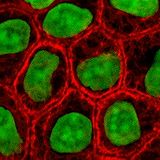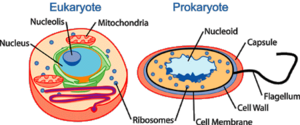Cell (biology)
The cell is the structural and functional unit of all living organisms, and is sometimes called the "building block of life."[1] Some organisms, such as bacteria, are unicellular, consisting of a single cell. Other organisms, such as humans, are multicellular, (humans have an estimated 100 trillion or 1014 cells; a typical cell size is 10 µm, a typical cell mass 1 nanogram). All vertebrate eggs are single cells, and the largest known cell is an ostrich egg.
The cell theory, first developed in 1839 by Schleiden and Schwann, states that all organisms are composed of one or more cells; all cells come from preexisting cells; all vital functions of an organism occur within cells, and cells contain the hereditary information necessary for regulating cell functions and for transmitting information to the next generation of cells.
The word cell comes from the Latin cellula, a small room. The name was chosen by Robert Hooke when he compared the cork cells he saw to the small rooms monks lived in.[2]
Overview
Properties of cells
Each cell is at least somewhat self-contained and self-maintaining: it can take in nutrients, and convert these nutrients into energy. Some cells carry out only specialized functions, and others carry out all the functions needed to mainatain life. Each cell stores its own set of instructions for carrying out each of these activities in the form of DNA, RNA and proteins.
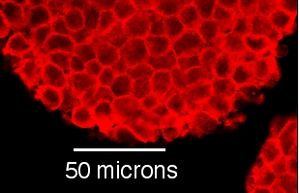
All cells share several abilities[3]:
- Reproduction by cell division (binary fission, mitosis or meiosis).
- Use of enzymes and other proteins coded for by DNA genes and made via messenger RNA intermediates and ribosomes.
- Metabolism, including taking in raw materials, building cell components, converting energy, molecules and releasing by-products. The functioning of a cell depends upon its ability to extract and use chemical energy stored in organic molecules. This energy is derived from metabolic pathways.
- Response to external and internal stimuli such as changes in temperature, pH or nutrient levels.
- Cell contents are contained within a cell surface membrane that contains proteins and a lipid bilayer.
Some prokaryotic cells contain important internal membrane-bound compartments, but eukaryotic cells have a highly specialized endomembrane system characterized by regulated traffic and transport of vesicles.[4]
Subcellular components
All cells, whether prokaryotic or eukaryotic, have a membrane, which envelopes the cell, separates its interior from its environment, regulates what moves in and out, and maintains the electric potential of the cell. Inside the membrane, a salty cytoplasm takes up most of the cell volume. All cells possess DNA, the hereditary material of genes, and RNA, containing the information necessary to build various proteins such as enzymes, the cell's primary machinery. There are also other kinds of biomolecules in cells. This article will list these primary components of the cell, then briefly describe their function.
Cell membrane: A cell's defining boundary
- Main article: Cell membrane
The cytoplasm of a cell is surrounded by a plasma membrane. This membrane serves to separate and protect a cell from its surrounding environment and is made mostly from a double layer of lipids (hydrophobic fat-like molecules) and hydrophilic phosphorous molecules. Hence the layer is called a phospholipid bilayer. Embedded within this membrane is a variety of protein molecules that act as channels and pumps that move different molecules into and out of the cell. The membrane is said to be 'semi-permeable', in that it can either let a substance (molecule or ion) pass through freely, pass through to a limited extent or not pass through at all. Cell surface membranes also contain receptor proteins that allow cells to detect external signalling molecules such as hormones, many of these receptors are coupled to the channels and pumps that control the contents of the cell's cytoplasm.
The plasma membrane in plants and prokaryotes is usually covered by an outer cell wall.
Cytoskeleton: A cell's scaffold
- Main article: Cytoskeleton
The cytoskeleton acts to organize and maintain the cell's shape; anchors organelles in place; helps during endocytosis, the uptake of external materials by a cell, and cytokinesis, the separation of daughter cells after cell division; and provides both stability and propulsion of the cytoplasm for growth and movement. The eukaryotic cytoskeleton is composed of microfilaments, intermediate filaments and microtubules. There are many families of other proteins associated with the cytoskeletal filament proteins, each controlling a cell's structure by directing, bundling, and aligning the filaments.
Genetic material
Two different kinds of genetic material exist: deoxyribonucleic acid (DNA) and ribonucleic acid (RNA). Most organisms use DNA for their long-term information storage, but some viruses (e.g., retroviruses) have RNA as their genetic material. The biological information contained in an organism is encoded in its DNA or RNA sequence. RNA is also used for information transport (e.g., mRNA) and enzymatic functions (e.g., ribosomal RNA) in organisms that use DNA for the genetic code itself. Proteins can bind to genetic material and either block or promote their operation.
Prokaryotic genetic material is organized in a simple circular DNA molecule (the bacterial chromosome) in the nucleoid region of the cytoplasm. Eukaryotic genetic material is divided into different, linear molecules called chromosomes inside a discrete nucleus, usually with additional genetic material in some organelles like mitochondria and chloroplasts (see endosymbiotic theory).
A human cell has genetic material both in the nucleus (the nuclear genome) and in the mitochondria (the mitochondrial genome). In humans the nuclear genome is divided into 46 linear DNA molecules called chromosomes and the mitochondrial genome is a circular DNA molecule that is separate from the nuclear DNA. Although the mitochondrial genome is very small, it codes for some important proteins. Like all vertebrates, each person inherits mitochondrial DNA only from his or her mother. That's because only the nucleus of the sperm cell becomes part of the fertilized egg, the {{zygote]]. The mitochondrial DNA in the ovum divides with the zygote and supplies the entire organism that developes from it.
Foreign genetic material (most commonly DNA) can also be artificially introduced into the cell by a process called transfection. This can be transient, if the DNA is not inserted into the cell's genome, or stable, if it is.
Organelles
- Main article: Organelle
The human body contains many different organs, such as the heart, lung, and kidney, with each organ performing a different function. Cells also have a set of "little organs," called organelles, that are adapted and/or specialized for carrying out one or more vital functions. Membrane-bound organelles are found only in eukaryotes.
|

| ||||||||||||||||||||||||||||||||||||||||||||||||
| |||||||||||||||||||||||||||||||||||||||||||||||||
|
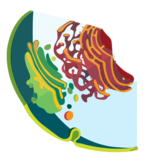
| ||||||||||||||||||||||||||||||||||||||||||||||||
| |||||||||||||||||||||||||||||||||||||||||||||||||
| |||||||||||||||||||||||||||||||||||||||||||||||||
| |||||||||||||||||||||||||||||||||||||||||||||||||
Anatomy of cellsThere are two types of cells, eukaryotic and prokaryotic. Prokaryotic cells are usually singletons, while eukaryotic cells are usually found in multi-cellular organisms. Prokaryotic cells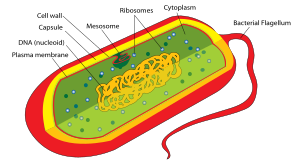 A typical prokaryotic cell Prokaryotes are distinguished from eukaryotes on the basis of nuclear organization, specifically their lack of a nuclear membrane. Prokaryotes also lack most of the intracellular organelles and structures that are characteristic of eukaryotic cells (an important exception is the ribosomes, which are present in both prokaryotic and eukaryotic cells). Most of the functions of organelles, such as mitochondria, chloroplasts, and the Golgi apparatus, are taken over by the prokaryotic plasma membrane. Prokaryotic cells have three architectural regions: appendages called flagella and pili — proteins attached to the cell surface; a cell envelope consisting of a capsule, a cell wall, and a plasma membrane; and a cytoplasmic region that contains the cell genome (DNA) and ribosomes and various sorts of inclusions. Other differences include:
Eukaryotic cellsFile:Biological cell.png A typical eukaryotic cell Eukaryotic cells are about 10 times the size of a typical prokaryote and can be as much as 1000 times greater in volume. The major difference between prokaryotes and eukaryotes is that eukaryotic cells contain membrane-bound compartments in which specific metabolic activities take place. Most important among these is the presence of a cell nucleus, a membrane-delineated compartment that houses the eukaryotic cell's DNA. It is this nucleus that gives the eukaryote its name, which means "true nucleus". Other differences include:
Cell functionsCell growth and metabolism
Between successive cell divisions, cells grow through the functioning of cellular metabolism. Cell metabolism is the process by which individual cells process nutrient molecules. Metabolism has two distinct divisions: catabolism, in which the cell breaks down complex molecules to produce energy and reducing power, and anabolism, wherein the cell uses energy and reducing power to construct complex molecules and perform other biological functions. Complex sugars consumed by the organism can be broken down into a less chemically-complex sugar molecule called glucose. Once inside the cell, glucose is broken down to make adenosine triphosphate (ATP), a form of energy, via two different pathways. The first pathway, glycolysis, requires no oxygen and is referred to as anaerobic metabolism. Each reaction is designed to produce some hydrogen ions that can then be used to make energy packets (ATP). In prokaryotes, glycolysis is the only method used for converting energy. The second pathway, called the Krebs cycle, or citric acid cycle, occurs inside the mitochondria and is capable of generating enough ATP to run all the cell functions.  An overview of protein synthesis. Within the nucleus of the cell (light blue), genes (DNA, dark blue) are transcribed into RNA. This RNA is then subject to post-transcriptional modification and control, resulting in a mature mRNA (red) that is then transported out of the nucleus and into the cytoplasm (peach), where it undergoes translation into a protein. mRNA is translated by ribosomes (purple) that match the three-base codons of the mRNA to the three-base anti-codons of the appropriate tRNA. Newly-synthesized proteins (black) are often further modified, such as by binding to an effector molecule (orange), to become fully active. Creation of new cells
Cell division involves a single cell (called a mother cell) dividing into two daughter cells. This leads to growth in multicellular organisms (the growth of tissue) and to procreation (vegetative reproduction) in unicellular organisms. Prokaryotic cells divide by binary fission. Eukaryotic cells usually undergo a process of nuclear division, called mitosis, followed by division of the cell, called cytokinesis. A diploid cell may also undergo meiosis to produce haploid cells, usually four. Haploid cells serve as gametes in multicellular organisms, fusing to form new diploid cells. DNA replication, or the process of duplicating a cell's genome, is required every time a cell divides. Replication, like all cellular activities, requires specialized proteins for carrying out the job. Protein synthesis
Cells are capable of synthesizing new proteins, which are essential for the modulation and maintenance of cellular activities. This process involves the formation of new protein molecules from amino acid building blocks based on information encoded in DNA/RNA. Protein synthesis generally consists of two major steps: transcription and translation. Transcription is the process where genetic information in DNA is used to produce a complimentary RNA strand. This RNA stand is then processed to give messenger RNA (mRNA), which is free to migrate through the cell. mRNA molecules bind to protein-RNA complexes called ribosomes located in the cytosol, where they are translated into polypeptide sequences. The ribosome mediates the formation of a polypeptide sequence based on the mRNA sequence. The mRNA sequence directly relates to the polypeptide sequence by binding to transfer RNA (tRNA) adapter molecules in binding pockets within the ribosome. The new polypeptide then folds into a functional 3D protein molecule. Origins of cells
The origin of cells has to do with the origin of life, and was one of the most important steps in evolution of life as we know it. The birth of the cell marked the passage from prebiotic chemistry to biological life. Origin of the first cellIf life is viewed from the point of view of replicators, that is DNA molecules in the organism, cells satisfy two fundamental conditions: protection from the outside environment and confinement of biochemical activity. The former condition is needed to maintain the fragile DNA chains stable in a varying and sometimes aggressive environment, and may have been the main reason for which cells evolved. The latter is fundamental for the evolution of biological complexity. If freely-floating DNA molecules that code for enzymes are not enclosed into cells, the enzymes that benefit a given DNA molecule (for example, by producing nucleotides) will automatically benefit the neighbouring DNA molecules. This might be viewed as "parasitism by default." Therefore the selection pressure on DNA molecules will be much lower, since there is not a definitive advantage for the "lucky" DNA molecule that produces the better enzyme over the others: All molecules in a given neighbourhood are almost equally advantaged. If all the DNA molecule is enclosed in a cell, then the enzymes coded from the molecule will be kept close to the DNA molecule itself. The DNA molecule will directly enjoy the benefits of the enzymes it codes, and not of others. This means other DNA molecules won't benefit from a positive mutation in a neighbouring molecule: this in turn means that positive mutations give immediate and selective advantage to the replicator bearing it, and not on others. This is thought to have been the one of the main driving force of evolution of life as we know it. (Note. This is more a metaphor given for simplicity than complete accuracy since the earliest molecules of life, probably up to the stage of cellular life, were most likely RNA molecules that acted as both replicators and enzymes: see RNA world hypothesis. However, the core of the reasoning is the same.) Biochemically, cell-like spheroids formed by proteinoids are observed by heating amino acids with phosphoric acid as a catalyst. They bear much of the basic features provided by cell membranes. Proteinoid-based protocells enclosing RNA molecules could (but not necessarily should) have been the first cellular life forms on Earth. Another theory holds that the turbulent shores of the ancient coastal waters may have served as a mammoth laboratory, aiding in the countless experiments necessary to bring about the first cell. Waves breaking on the shore create a delicate foam composed of bubbles. Winds sweeping across the ocean have a tendency to drive things to shore, much like driftwood collecting on the beach. It is possible that organic molecules were concentrated on the shorelines in much the same way. Shallow coastal waters also tend to be warmer, further concentrating the molecules through evaporation. While bubbles comprised of mostly water tend to burst quickly, oily bubbles happen to be much more stable, lending more time to the particular bubble to perform these crucial experiments. The Phospholipid is a good example of a common oily compound prevalent in the prebiotic seas. Phospholipids can be constructed in ones mind as a hydrophilic head on one end, and a hydrophobic tail on the other. Phospholipids also possess an important characteristic, that is being able to link together to form a bilayer membrane. A lipid monolayer bubble can only contain oil, and is therefore not conducive to harbouring water-soluble organic molecules. On the other hand, a lipid bilayer bubble [1] can contain water, and was a likely precursor to the modern cell membrane. If a protein came along that increased the integrity of its parent bubble, then that bubble had an advantage, and was placed at the top of the natural selection waiting list. Primitive reproduction can be envisioned when the bubbles burst, releasing the results of the experiment into the surrounding medium. Once enough of the 'right stuff' was released into the medium, the development of the first prokaryotes, eukaryotes, and multi-cellular organisms could be achieved. This theory is expanded upon in the book, The Cell: Evolution of the First Organism by Joseph Panno Ph.D. Origin of eukaryotic cellsThe eukaryotic cell seems to have evolved from a symbiotic community of prokaryotic cells. It is almost certain that DNA-bearing organelles like the mitochondria and the chloroplasts are what remains of ancient symbiotic oxygen-breathing bacteria and cyanobacteria, respectively, where the rest of the cell seems to be derived from an ancestral archaean prokaryote cell – a theory termed the endosymbiotic theory. There is still considerable debate about whether organelles like the hydrogenosome predated the origin of mitochondria, or viceversa: see the hydrogen hypothesis for the origin of eukaryotic cells. History
See also
References
External linksTemplate:Commons Template:Wikibookspar
Online textbooks
Template:Link FA Template:Link FA ar:خلية bn:কোষ (জীববিজ্ঞান) zh-min-nan:Sè-pau bg:Клетка ca:Cèl·lula cs:Buňka cy:Cell da:Celle (biologi) de:Zelle (Biologie) et:Rakk el:Κύτταρο es:Célula (Biología) eo:Biologia ĉelo eu:Zelula fa:یاخته fr:Cellule (biologie) gl:Célula ko:세포 hr:Stanica io:Celulo id:Sel (Biologi) is:Fruma it:Cellula he:תא ku:Şane la:Cellula lt:Ląstelė lv:Šūna hu:Sejt mk:Клетка ms:Sel (biologi) nl:Cel (biologie) ja:細胞 no:Celle nn:Celle pl:Komórka (biologia) pt:Célula ru:Клетка sq:Qeliza simple:Cell sk:Bunka (biológia) sl:Celica sr:Ћелија (биологија) su:Sél (biologi) fi:Solu sv:Cell ta:கலம் th:เซลล์ (ชีววิทยา) vi:Tế bào tr:Hücre uk:Клітина (біологія) ur:خلیہ zh:细胞 |
|||||||||||||||||||||||||||||||||||||||||||||||||
